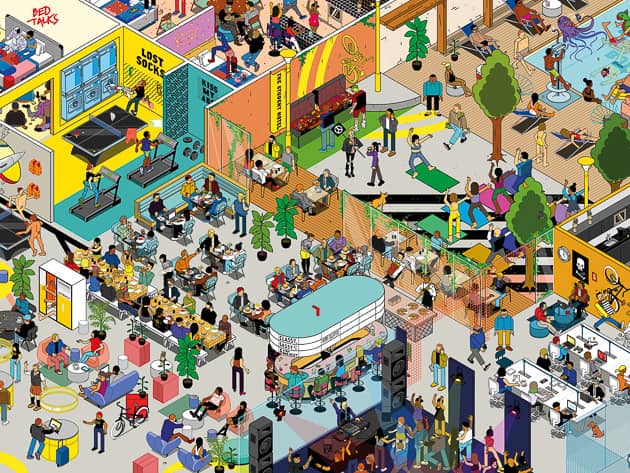Building on the success of coworking, coliving emerges as a natural extension within the same ecosystem. This new approach is shaped by the core elements behind coworking’s rise—community, sharing, resource pooling, and adaptability—while sharing a common goal: reimagining property use through dynamic, service-driven management models. Coliving introduces an advanced evolution of shared living experiences by blending traditional flat-sharing with the amenities and convenience of hospitality services. At its core, coliving integrates robust technological solutions to serve the expectations of its primary demographic: young professionals who demand seamless, high-performance internet and WiFi connectivity. Although this concept originated in the US and is still gaining traction across Europe, its growth trajectory indicates significant potential for widespread adoption in the near future.
What is coliving?
Coliving combines the principles of shared living, hospitality-driven services, professionally managed residences, and serviced apartments into a unified, innovative model. While coworking has transformed approaches to commercial real estate, coliving seeks to redefine residential norms with flexible, turnkey housing designed for individuals in transition—particularly young professionals, but also students and active seniors.
Coliving is fundamentally designed for urban environments, leveraging shared spaces to optimise costs for residents. This model aligns perfectly with the needs of major cities, where high property prices can create barriers to access. Its flexible leasing options—from one month to a year—and streamlined administrative processes make quality accommodation both accessible and straightforward, regardless of an individual’s situation.
A comprehensive service model underpins this integrated housing solution, offering residents an all-inclusive rent that covers utilities such as water, energy, cleaning, laundry, WiFi, and even home insurance—all in exchange for a fully equipped private apartment and access to thoughtfully designed shared spaces.
What truly distinguishes coliving is the sense of community it nurtures among residents. Regularly organised in-house events encourage meaningful social interaction, while a comprehensive suite of on-site amenities—including cafés, fitness centres, coworking spaces, and concierge services—further enhances the resident experience.
 Illustration of the community aspect at The Student Hotel © thestudenthotel.com
Illustration of the community aspect at The Student Hotel © thestudenthotel.com
A breakthrough or a reimagining of existing models?
When examining the details of coliving, clear parallels emerge with established concepts such as student residences and senior living facilities. Does coliving represent a true revolution in residential solutions, or is it simply an enhanced, more premium iteration of managed accommodation?
Coliving is carving out a distinct space as an innovative type of managed residence, specifically targeting young professionals and individuals in transition—a demographic situated between traditional student housing and senior living, which has historically been underserved. Its offering aligns with the needs of this segment, both in concept and pricing. While students may find appeal in the coliving model, costs could be a limiting factor for some. As the sector evolves, three key trends are shaping the future of coliving:
- Purpose-built coliving residences by specialised operators
The rise of coliving has led to new specialist providers like Outsite Coliving in Lisbon, one of Portugal’s largest sites, offering over 30 en-suite bedrooms and multiple shared kitchens.
Another example is Coconat, a German company focused on positive social impact, combining tourism, workation, coworking, coliving, and rural development projects. Student housing operators are increasingly entering the coliving market. The Fizz has broadened its services to young professionals in Germany and the Netherlands. The Student Hotel, traditionally catering to students, is expanding to welcome a wider audience, reflecting the market’s adaptation to coliving trends.
- Conversion of hotels and serviced residences to coliving models
Coliving is driving the modernisation of hotels and serviced residences. The hospitality industry, already evolving with coworking concepts, now sees coliving integrated into spaces like Mama Shelter Luxembourg, which features the group’s coworking brand, Mama Works. In student sectors, coliving challenges traditional models, prompting operators to adapt their offerings.
Novovento, a youth hostel on São Miguel Island in the Azores, adopts a coliving model during the summer to cater to digital nomads seeking a productive, relaxing environment. Hotel Schani Wien is a pioneer in Europe, operating as the first coworking hotel dedicated to international travelers.
- Integrating multiple service types within coliving models
Station F stands out as the world’s largest campus for start-ups, offering far more than just workspaces. The addition of La Felicità provides on-site catering, while the Flatmates complex introduces coliving accommodation with 100 shared apartments tailored for entrepreneurs.
Coliving segment diversity
Looking at the sector in detail, coliving encompasses a variety of residence types, each defined by factors such as:
- target audience
- resident capacity
- accommodation type
- location
- range of services
- and available activities
Here are key examples highlighting the diversity within the coliving sector:

1 / The Social Hub is a pioneer in global coliving, opening its first site in 2012 to reinvent student hospitality. Today, it offers a "hybrid hospitality" model that serves not only students but also business travellers, tourists, and professionals, combining hotel, student residence, and coworking facilities under one roof.

2 / Outsite is a global coliving network designed for remote professionals—telecommuters, freelancers, and creatives. With properties worldwide, Outsite offers flexible living, coworking, and fosters community, catering especially to a nomadic clientele seeking both productivity and social connection.

3 / Sun and Co, located on Spain’s east coast, combines city life, coastal access, and nature to create a homelike environment. Emphasising both professional and personal growth, it offers weekly events, skill exchanges, and goal-setting workshops, allowing residents to immerse themselves in a supportive community while pursuing their projects.
WiFi: a critical feature in all coliving spaces
WiFi is a non-negotiable standard in coliving spaces, essential for modern living and connectivity needs.
"As Europe’s leading provider of managed WiFi for collective accommodation, Wifirst recognises that reliable connectivity is a decisive factor in guest satisfaction—whether for short or long stays." - Etienne Détrie, Marketing Director at Wifirst
With increasing mobile device use, streaming services, and cloud gaming, bandwidth demands are rising. Many coliving providers now include services like Netflix and Spotify in their offerings.
The growth of IoT, Smart Homes, and connected rooms is reshaping expectations for residential connectivity. Beyond entertainment (like Smart TVs and WiFi speakers), home automation enhances energy efficiency, safety, and comfort through smart control. Reliable WiFi in common areas—especially coworking spaces—is essential to meet high bandwidth demand and varied usage patterns across all resident types.
"Delivering high-quality WiFi in student residences and coworking spaces requires specialised expertise and highly robust infrastructure. To meet user expectations and usage intensity, coliving environments must be equipped with advanced, reliable network solutions." - Vincent Guilbeau, Director of Operations at Wifirst
- Wifi (35)
- Hotel Industry (18)
- Digital Workplace (13)
- Behind the scenes (8)
- IPTV - Signage (8)
- Optical fibre (7)
- Green-IT (5)
- Retail (5)
- Education (3)
- Healthcare (2)
- Cybersecurity (1)
- General (1)
- Hospitality (1)
- PBSA (1)
- Student Accommodation (1)
- Telephony (1)
- Tips and tricks (1)
- Tourism (1)
- Wifirst (1)
You May Also Like
These Related Stories

What is WiFi as a Service?

The Power of WiFi and AI Integration
